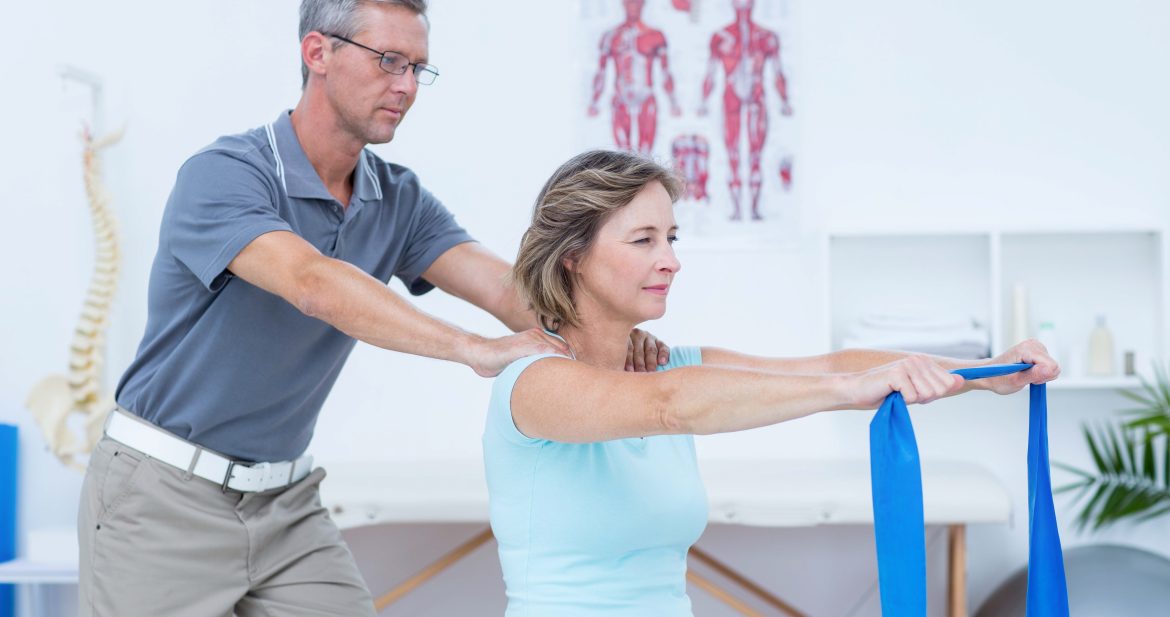If you’re trying to fix your hunched back, you’ve probably tried a few posture correction exercises. These usually consist of stretching tight muscles and strengthening weak ones that contribute to poor posture.
They sometimes also teach you to hold their body in an upright, “correct” position. Most people find this type of posture correction painful and exhausting.
And also, it doesn’t work.
Clients who come to my office with poor posture have usually worked with a personal trainer, maybe even a physical therapist, and yet they still struggle with poor posture.
Why is this? Computers. It must be because you’re sitting in front of a computer all day. Right?
While computers aren’t great for us for a number of reasons, they’re not solely to blame for the failure of posture correction exercises. There are a number of reasons these practices don’t get results.
Here are five reasons posture correction exercises don’t work:
1. They treat the symptom, not the problem.
When it comes to posture, it’s all about shoulders, shoulders, shoulders! (To be said like Marcia, Marcia, Marcia, of course.)
But seriously, when it comes to fixing posture, pretty much everyone thinks it’s about getting your shoulders back.
Which is great and all….if the rib cage that they sit upon isn’t collapsed forward, yanked down by tight abdominals and hip flexor muscles.
Trying to correct your shoulder position without also addressing rib cage alignment is like putting a new roof on a house with a collapsing foundation. Sure, it looks pretty for a minute.
But it’s not going to take long for it to fall apart again.
The bottom line: when correcting posture, you HAVE to take a whole body approach, or you’re just going to be on the hamster wheel of posture correction exercises that only give temporary results.
2. They require ongoing conscious effort.
Do a quick YouTube search for “posture” and you’ll see a plethora of videos telling you how to hold your head and neck, ways to position your back and the “right” way to stand.
Cue posture professional’s disgusted grimace.
Sorry, but that stuff DOESN’T WORK.
Here’s why…
Putting your body into a position and holding it takes conscious muscular effort. You have to physically hold yourself in place.
Which sounds reasonable until you consider that you do NOT have to physically hold yourself upright when you sit, stand or walk. You simply do the activity and somehow you don’t collapse into a puddle on the floor.
Your body is self organizing. Parts of your brain that you do not consciously control are perpetually sensing your body’s position in relation to your environment and adjusting your movement as necessary.
That’s how it’s supposed to work. If you had to think about every little muscle that you had to contract in order to stand up and walk across a room, you’d never make it.
So the idea that you can somehow “mind” your body like an ever-present nanny is a bit ridiculous. Instead, what needs to happen is adjustments to the parts of your brain that coordinate your posture and movement in the first place…like a neural reset.
3. They do nothing to teach body awareness.
Wait, didn’t I just say that you can’t consciously mind your body 24/7 and hold it in place?
Yes, yes I did.
And also, you need SOME level of body awareness. I don’t mean the kind of awareness where you’re micromanaging every tiny movement and position of your body. We tend to get really hung up on that kind of stuff…like, is crossing my legs bad for my hips? What’s the best body position for sleeping?
That stuff is kind of irrelevant if you have body awareness. Because when something is uncomfortable, your body will tell you. It will tell you long before it becomes a problem.
Unfortunately, most people have been taught to ignore their body signals. As children, we underwent grueling training for how to sit in a chair and not move all day.
We were instructed on how to ignore our urges to stand, move, stretch, run, play, bounce, even to simply fidget.
And we carry those lessons into adulthood. But if you learn to listen again, you’ll find that your body is still talking, still telling you exactly what it needs in any moment.
All it takes is practice.
4. Posture is dynamic and individual.
If I never see another person lined up against a grid on a wall again, it will be too soon. How ridiculous are we believing that people can be measured in lines and squares?
We are organic creatures — organisms, for crying out loud! We are not rectangles.
Most exercises prescribe the same movements and body positions for all people regardless of height, body type and individual structure. Everybody’s body is different.
That statement is so cliche that you might just gloss right over it. But it’s cliche because it’s true.
Not only do we come in different heights and widths, we also have different joint shapes, bone lengths…even the orientation of your hip joint can be unique!
So, to assume that there is one “right” posture is misguided at best. The right posture for you is the one that simultaneously gives you the greatest ease while also allowing the most potential for movement.
And that’s going to be unique to you.
5. Posture runs deeper than body position.
Finally, no article on the failure of posture correction exercises would be complete without at least a mention of the neuro-psychological aspects of body position.
You might actually call it body language. Other synonyms for posture include “attitude,” “stance,” and “comportment.”
All words that connote not just physical alignment, but also cognitive orientation.
How much of a person’s communication do you read through their gestures and expressions? Quite a lot, actually. 55% of meaning in communication can be gleaned from a person’s body language.
We tend to think of these things as overlays on a neutral posture — like shrugging your shoulders or crossing your arms. Those specific gestures have meaning, sure.
But everyone’s baseline body position — i.e. your posture — is as unique to them as a fingerprint. Your posture is the sum neurological total of your lived experience.
You have learned and mimicked movement patterns of your parents and caregivers, friends, community and greater culture at large. You have learned cultural mandates that form the walls of your movement repertoire, such as “good girls don’t swing their hips when they walk” or “shoulders back, suck in your gut.”
You have been told — overtly and covertly — what should move and what shouldn’t. And those beliefs both shape and constrain your movement.
Posture correction exercises simply overlay a new pattern, a new set of alignment “rules” on top of all the ones you’ve learned before — like donning a Gucci suit over the top of jeans and a sweatshirt.
It just doesn’t work.
Finally, Posture Correction Exercises That Work
I hope you’re getting a pretty good idea of a) what shapes your posture in the first place, and b) what’s required in order to get lasting posture and movement changes.
In sum…
You’ve got to dissolve all the layers of neural patterning and conditioning that are constraining your body now while simultaneously developing a broader range of more efficient neural patterns that will serve you better as you go forward in life.
Sound complicated? It’s really not. But it does take some effort.
And the good news is that it works. It works even if other stuff you’ve tried hasn’t. It works if you’re seventeen or seventy. It works if you’ve been in auto accidents or just have bad habits from years of ignoring your body.
Your brain and body are plastic, meaning they can change at any time.
If this is something you’re keen to explore, I’d like to invite you to check out my **free** Pain Free At Any Age video series that will help you start the process of dissolving those pesky neural habits that are causing you so much pain.
Click the banner below to create your free account and start your journey to living with less pain today.


Leave a Reply